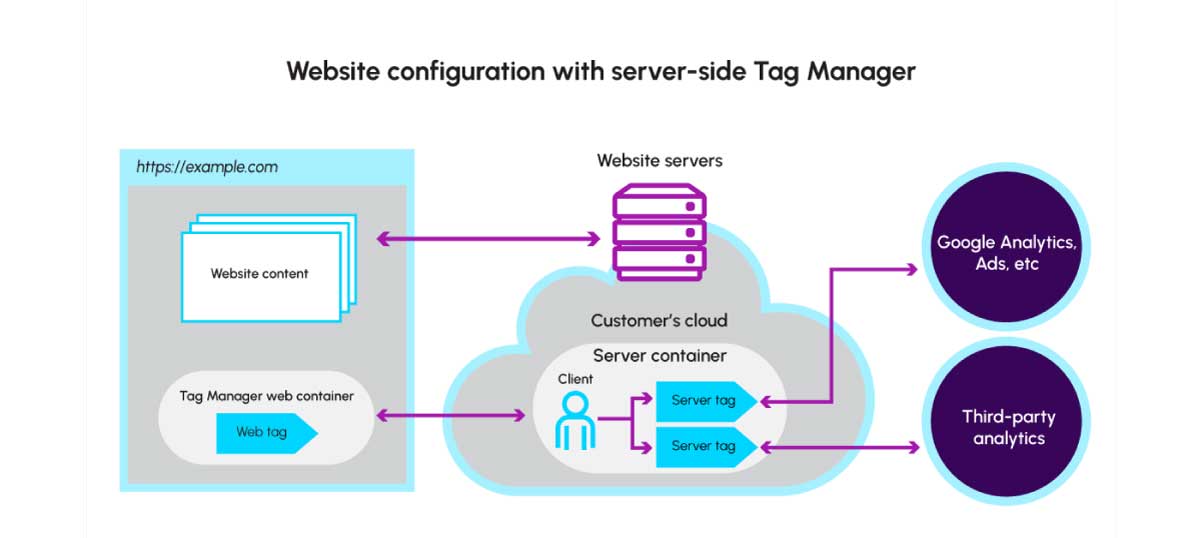As consumers become increasingly concerned with data security, businesses need to adjust their digital strategies to meet their performance goals without compromising customer privacy needs. Fortunately, Server-Side Tagging in Google Tag Manager (GTM) enables teams to increase control over their data and improve the user experience even in a cookieless environment.
Let’s talk details…
What is Server-Side Tagging?
Server-side tagging is a process that allows you to control how data is processed and sent to third-party vendors on your website or application. Think of a proxy as a middleman that processes incoming requests before sending them to the vendor endpoint. By using the server as a proxy, you can have greater control over data shaping and endpoint destinations. It’s important to note that while server-side tagging is useful, you still need to use a traditional GTM web container for sending requests from a user’s browser or app to the server-side container.
This allows the analytics platform to collect and process data on the server side rather than relying solely on client-side scripts that run on the user’s device, which is particularly useful when users employ ad blockers or security software that block tracking scripts. Overall, side-server tagging helps website and app developers gain insights into user behaviour and optimise their digital properties to provide a better user experience.
Benefits of Server-Side Tagging
Now that we’ve explored what server-side tagging entails, let’s look at some of the benefits:
Improved Performance
Server-side tagging reduces the amount of client-side processing required to load the contents of a web page, as tags are processed on your business’s in-house or cloud server instead. This means that the user’s device doesn’t need to perform as much processing as it normally would, which results in faster load times and an improved customer experience.
Increased Security
A typical tagging configuration required data to be executed on the user’s device, putting it at risk of unknowingly running malicious code and compromising its information. Server-side tagging gives your business more control over who has access to data configuration and takes the burden off your customers’ phones or computers. This significantly reduces the risk of cyber-attacks and improves data security.
First-Party Context for Cookies
Each Server-Side GTM container offers its own endpoint which is where all HTTP requests are sent to be processed by the Server-Side GTM container. This endpoint can be mapped with a custom subdomain, sharing the same domain as your site. This means that any cookies set by Server-Side GTM will be in first-party context, which drastically changes how browser-tracking protections treat the cookie. Additionally, it also helps prevent issues with the blocking of 3rd party scripts which is becoming increasingly common in today’s world of user privacy.
Content-Security Policies
Many sites today have a content security policy (CSP) in place which allows sites to control which resources a user agent is allowed to load for a given page. With current GTM, a site may have to exclude every vendor domain (i.e Google Analytics, Facebook) from their CSP in order to send hits to a vendor. This of course reduces the overall effectiveness of having a CSP in place.
As each Server-Side GTM container can be mapped to a custom domain and is responsible for sending outgoing hits to vendors, only the GTM subdomain endpoints needs to be whitelisted from a CSP with all other vendor endpoints disallowed from being loaded on a site.
This contributes to both an improvement in CSP effectiveness and a reduction in the maintenance of a CSP when different vendors are introduced into an analytics implementation.
Full Control Over The Data
With the introduction of the Client entity, the Server-Side GTM container has complete control over the incoming measurement data as well as the outgoing HTTP requests to different vendor endpoints. Every request can be processed differently, modified and cleaned for sensitive information before being sent to a vendor collection endpoint. Furthermore a single incoming HTTP request can be split into multiple events and then sent to different multiple vendors, helping to streamline the overall analytics implementation.
What Issue Does Server-Side Tagging Solve?
In an increasingly privacy-conscious landscape, server-side tagging solves the issue of website performance and security that arises with client-side tagging. Client-side tagging involves placing tracking codes and marketing tags on a website that runs directly on the user’s device. This can lead to slower load times, increased risk of data breaches, and potential compatibility issues. Server-side tagging processes these tags on a server before being sent to the user’s device, reducing the amount of processing required on the client-side and increasing website speed and performance. Additionally, server-side tagging can centralise and control data, reduce the risk of security breaches, and enable granular access control.
For more information on how to establish server-side tagging for improved performance and security, get in touch with the team at XPON.
As a full-stack Google Marketing Platform & Google Cloud Partner, XPON Technologies AUNZ can help you seamlessly transition to server-side tagging.
